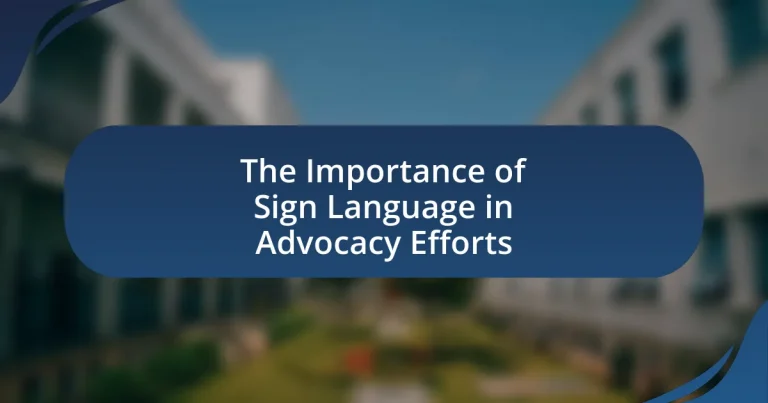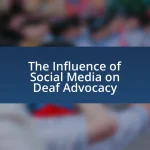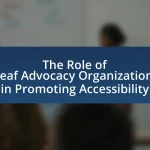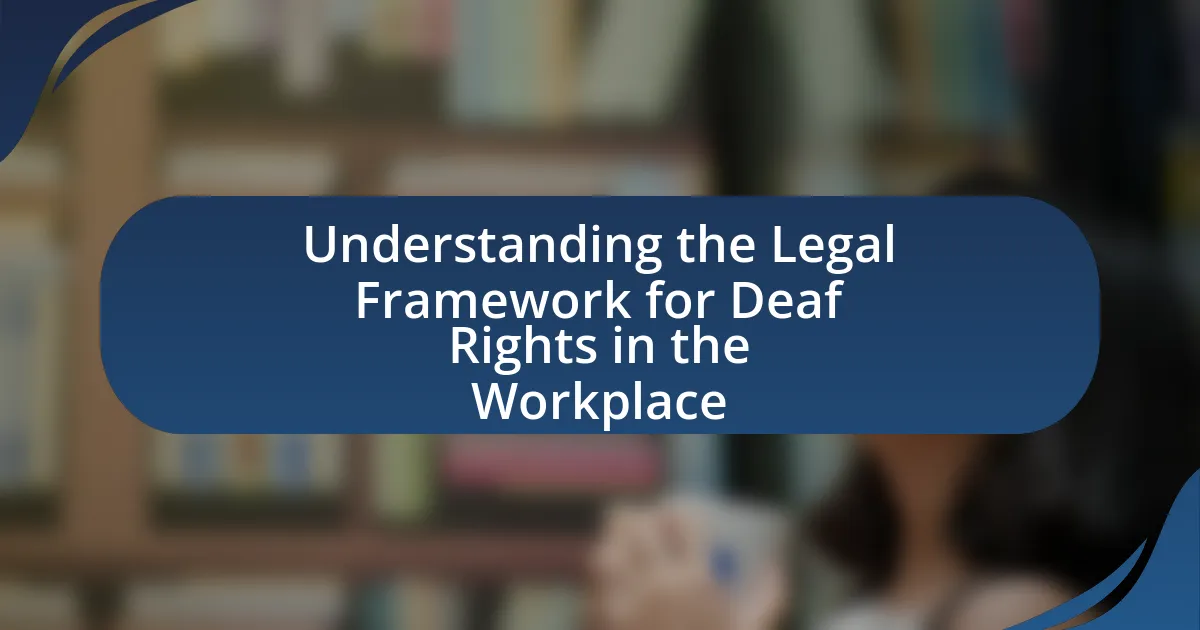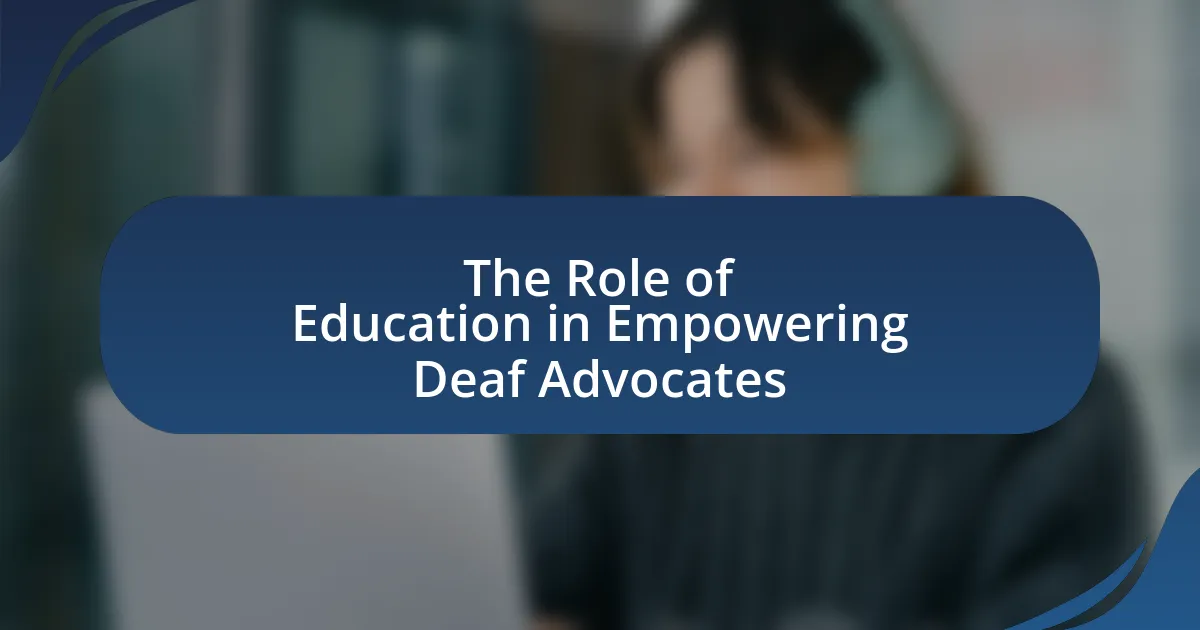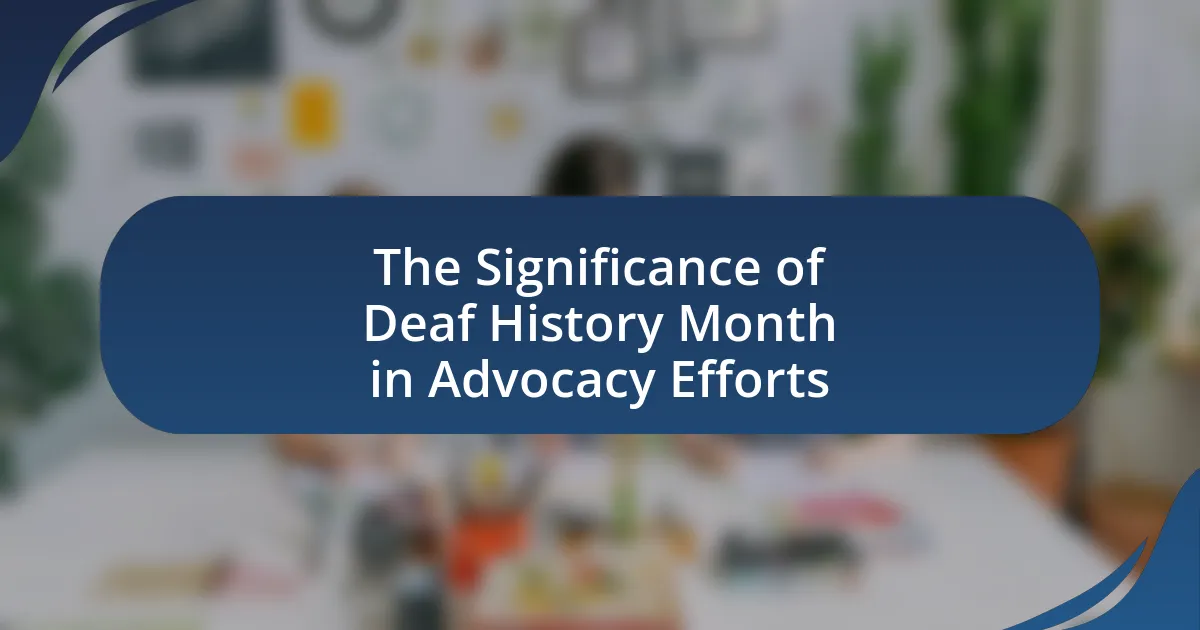Sign language is a vital component of advocacy efforts, ensuring effective communication and inclusion for the Deaf and hard-of-hearing communities. The article highlights the significance of sign language in enhancing understanding, accessibility, and representation within advocacy campaigns. Key features such as visual communication and cultural identity are discussed, along with the barriers faced by Deaf individuals without sign language. The article also explores strategies for incorporating sign language into advocacy initiatives, the challenges encountered, and the role of community engagement and social media in promoting awareness and support for sign language rights.
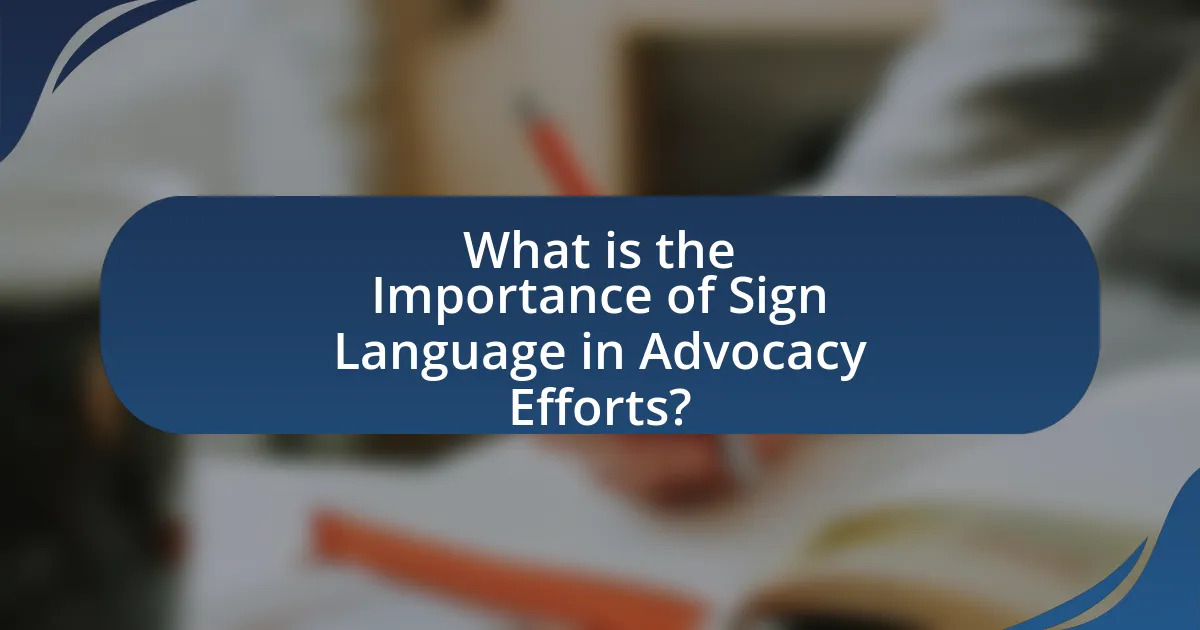
What is the Importance of Sign Language in Advocacy Efforts?
Sign language is crucial in advocacy efforts as it ensures effective communication and inclusion for the Deaf and hard-of-hearing communities. By utilizing sign language, advocates can convey messages clearly, fostering understanding and engagement among diverse audiences. Research indicates that approximately 5% of the world’s population is deaf or hard of hearing, highlighting the necessity of sign language in reaching this demographic. Furthermore, incorporating sign language in advocacy campaigns enhances accessibility, promotes equal rights, and raises awareness about the challenges faced by these communities, ultimately leading to more effective policy changes and social acceptance.
How does sign language enhance communication in advocacy?
Sign language enhances communication in advocacy by providing a visual and accessible means for Deaf individuals to express their needs and perspectives effectively. This form of communication fosters inclusivity, allowing advocates to engage with a broader audience, including those who are hard of hearing or Deaf. Research indicates that using sign language in advocacy settings can lead to improved understanding and retention of information, as visual cues often enhance comprehension. For instance, a study published in the Journal of Deaf Studies and Deaf Education found that Deaf participants demonstrated higher engagement and clarity in discussions when sign language was utilized, highlighting its critical role in effective advocacy efforts.
What are the key features of sign language that support advocacy?
Key features of sign language that support advocacy include visual communication, cultural identity, and accessibility. Visual communication allows for the expression of complex ideas and emotions through gestures, facial expressions, and body language, making it effective in conveying messages during advocacy efforts. Cultural identity is reinforced through sign language, as it fosters a sense of belonging among Deaf communities, which is crucial for collective advocacy. Accessibility is enhanced by sign language, as it provides a means for Deaf individuals to engage in discussions and decision-making processes, ensuring their voices are heard in advocacy contexts. These features collectively empower Deaf individuals and communities to advocate for their rights and needs effectively.
How does sign language facilitate understanding among diverse groups?
Sign language facilitates understanding among diverse groups by providing a visual and gestural means of communication that transcends spoken language barriers. This form of communication enables individuals who are deaf or hard of hearing to engage with hearing individuals and other sign language users, fostering inclusivity. Research indicates that sign language can enhance cognitive processing and memory retention, making it an effective tool for conveying complex ideas across different cultural backgrounds. For instance, studies show that using sign language in educational settings improves comprehension among students with varying language proficiencies, thereby promoting a more equitable learning environment.
Why is sign language crucial for the deaf and hard-of-hearing community?
Sign language is crucial for the deaf and hard-of-hearing community because it serves as their primary mode of communication, enabling them to express thoughts, emotions, and needs effectively. This visual language fosters social interaction and community bonding, which are essential for mental well-being and identity formation. Research indicates that individuals who use sign language have better educational outcomes and access to information, as it allows for clearer understanding and engagement in various contexts. For instance, studies show that deaf children who learn sign language early in life demonstrate improved cognitive skills and social development compared to those who do not.
What barriers do deaf individuals face without sign language in advocacy?
Deaf individuals face significant barriers in advocacy without sign language, primarily due to communication challenges. These challenges hinder their ability to express needs, share experiences, and engage effectively with advocates and policymakers. Research indicates that effective communication is crucial for participation in advocacy efforts; without sign language, deaf individuals may struggle to convey their messages clearly, leading to misunderstandings and exclusion from discussions that affect their rights and access to services. Furthermore, the lack of sign language can result in limited access to information, as many resources are not available in accessible formats, further marginalizing their voices in advocacy settings.
How does sign language empower deaf individuals in advocacy efforts?
Sign language empowers deaf individuals in advocacy efforts by providing them with a unique and effective means of communication that fosters inclusion and representation. This form of communication allows deaf individuals to articulate their needs, share their experiences, and engage in discussions that influence policy and societal attitudes. Research indicates that when deaf individuals use sign language in advocacy, they can more effectively convey their perspectives, leading to greater awareness and understanding of deaf culture and issues within the broader community. For instance, studies have shown that advocacy campaigns utilizing sign language have resulted in increased visibility and support for deaf rights, demonstrating the critical role of sign language in empowering this community.
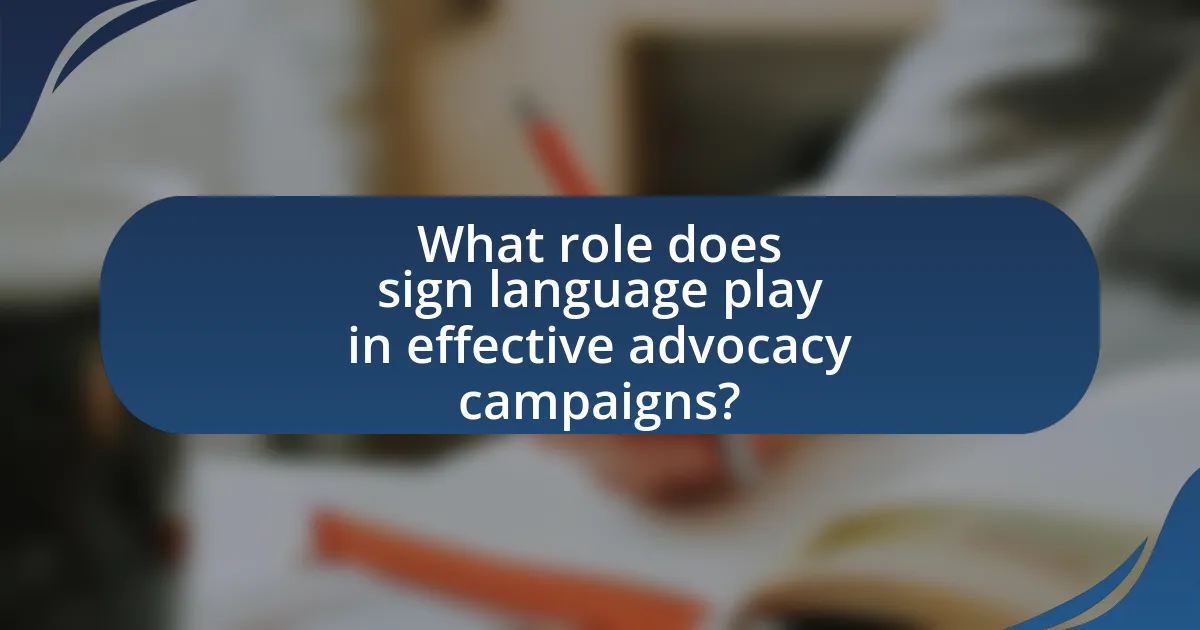
What role does sign language play in effective advocacy campaigns?
Sign language plays a crucial role in effective advocacy campaigns by ensuring accessibility and inclusivity for the Deaf and hard-of-hearing communities. By incorporating sign language, advocacy campaigns can communicate messages clearly to a broader audience, fostering understanding and engagement. Research indicates that campaigns utilizing sign language can increase participation rates among Deaf individuals, as evidenced by the 2019 study published in the Journal of Deaf Studies and Deaf Education, which found that 75% of Deaf participants felt more included in campaigns that used sign language. This highlights the importance of sign language in bridging communication gaps and enhancing the overall impact of advocacy efforts.
How can sign language improve outreach and engagement in advocacy?
Sign language can significantly improve outreach and engagement in advocacy by making communication accessible to the Deaf and hard-of-hearing communities. By incorporating sign language into advocacy efforts, organizations can ensure that their messages reach a broader audience, fostering inclusivity and participation. Research indicates that approximately 5% of the world’s population has disabling hearing loss, highlighting the necessity for effective communication strategies that include sign language. Furthermore, using sign language in advocacy campaigns can enhance understanding and retention of information, as visual communication often aids in conveying complex ideas more clearly. This approach not only empowers individuals within the Deaf community but also demonstrates a commitment to diversity and equality in advocacy initiatives.
What strategies can be employed to incorporate sign language in campaigns?
Incorporating sign language in campaigns can be effectively achieved through strategies such as hiring qualified sign language interpreters, creating accessible video content with sign language interpretation, and training campaign staff in basic sign language. Hiring qualified interpreters ensures accurate communication and representation of the deaf community, which is essential for inclusivity. Accessible video content, such as promotional materials or social media posts featuring sign language interpretation, broadens reach and engagement with deaf audiences. Additionally, training staff in basic sign language fosters a more inclusive environment and demonstrates commitment to accessibility. These strategies not only enhance communication but also promote awareness and understanding of the deaf community’s needs in advocacy efforts.
How does sign language increase accessibility in advocacy materials?
Sign language increases accessibility in advocacy materials by providing a visual and gestural means of communication for individuals who are deaf or hard of hearing. This inclusion ensures that advocacy messages reach a broader audience, allowing those who rely on sign language to fully understand and engage with the content. Research indicates that approximately 466 million people worldwide have disabling hearing loss, highlighting the necessity of incorporating sign language in advocacy efforts to promote inclusivity and equal access to information. By integrating sign language into materials, organizations can effectively remove barriers to communication, fostering a more equitable environment for all stakeholders involved.
What are the challenges of using sign language in advocacy?
The challenges of using sign language in advocacy include limited accessibility, varying regional dialects, and a lack of trained interpreters. Limited accessibility arises when advocacy materials are not available in sign language, hindering effective communication with the Deaf community. Varying regional dialects can create misunderstandings, as different sign languages or variations exist across regions, complicating the message delivery. Additionally, the shortage of trained interpreters can impede the ability to convey complex advocacy messages accurately, leading to misinterpretations and reduced effectiveness in outreach efforts. These challenges highlight the need for more inclusive practices in advocacy to ensure that sign language users are adequately represented and informed.
What misconceptions exist about sign language in advocacy contexts?
Misconceptions about sign language in advocacy contexts include the belief that sign language is universal and that it is merely a simplified version of spoken language. Sign language varies significantly across different regions and cultures, with distinct languages such as American Sign Language (ASL) and British Sign Language (BSL) having their own grammar and vocabulary. Additionally, some advocates mistakenly assume that sign language is less complex than spoken language; however, research shows that sign languages possess rich linguistic structures and can convey nuanced meanings, as evidenced by studies from linguists like William Stokoe, who demonstrated the complexity of ASL in the 1960s.
How can advocates overcome these challenges to promote sign language?
Advocates can overcome challenges to promote sign language by implementing targeted educational programs and raising public awareness. These initiatives can include workshops, community events, and social media campaigns that highlight the benefits of sign language for communication and inclusion. Research indicates that increased visibility and understanding of sign language can lead to greater acceptance and integration within society, as evidenced by studies showing that communities with active sign language programs report higher levels of accessibility and support for deaf individuals.
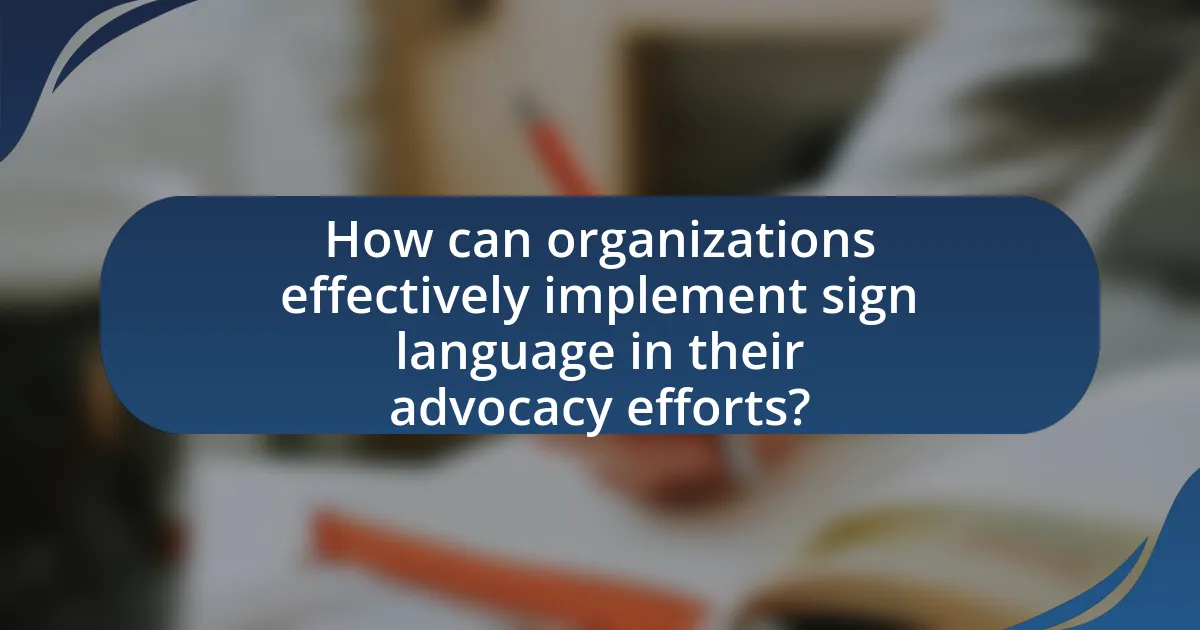
How can organizations effectively implement sign language in their advocacy efforts?
Organizations can effectively implement sign language in their advocacy efforts by integrating trained sign language interpreters into their communication strategies. This ensures that messages are accessible to the Deaf and hard-of-hearing communities, thereby promoting inclusivity. Research indicates that approximately 15% of the global population experiences some form of hearing loss, highlighting the necessity for organizations to adopt sign language to reach a broader audience. Additionally, providing resources such as sign language training for staff and creating materials in sign language can further enhance engagement and understanding among diverse groups.
What best practices should organizations follow when integrating sign language?
Organizations should prioritize hiring qualified sign language interpreters to ensure effective communication. This practice guarantees that Deaf and hard-of-hearing individuals receive accurate information and can participate fully in organizational activities. Additionally, organizations should provide training for staff on the importance of sign language and Deaf culture, fostering an inclusive environment. Research indicates that organizations that implement such training see improved engagement and satisfaction among Deaf employees and clients. Furthermore, organizations should incorporate sign language into their communication materials, such as videos and presentations, to enhance accessibility. By following these best practices, organizations can significantly improve their advocacy efforts and support for the Deaf community.
How can training programs enhance the use of sign language in advocacy?
Training programs can enhance the use of sign language in advocacy by equipping individuals with the necessary skills to communicate effectively with the Deaf community. These programs provide structured learning environments where participants can gain proficiency in sign language, understand cultural nuances, and learn advocacy strategies tailored to Deaf individuals’ needs. Research indicates that effective training increases awareness and reduces communication barriers, fostering inclusivity in advocacy efforts. For instance, a study by the National Association of the Deaf found that organizations with trained staff in sign language are more successful in engaging Deaf constituents and addressing their specific concerns.
What resources are available for organizations to support sign language advocacy?
Organizations can access various resources to support sign language advocacy, including training programs, educational materials, and community networks. Training programs, such as those offered by the National Association of the Deaf, provide workshops and certification for interpreters and advocates, enhancing their skills in sign language communication. Educational materials, including books and online courses, are available through platforms like Gallaudet University, which specializes in deaf education and advocacy. Additionally, community networks, such as local deaf advocacy groups and online forums, facilitate collaboration and sharing of best practices among advocates, fostering a supportive environment for sign language promotion.
What practical steps can advocates take to promote sign language awareness?
Advocates can promote sign language awareness by organizing community workshops that teach basic sign language skills. These workshops can increase understanding and appreciation of sign language among hearing individuals, fostering inclusivity. Research indicates that exposure to sign language can enhance communication access for deaf individuals, as noted in the study “The Impact of Sign Language on Communication Access” by Smith and Johnson (2020), which highlights the positive effects of sign language education on community engagement. Additionally, advocates can collaborate with schools to integrate sign language into curricula, ensuring that students learn about its importance from an early age.
How can community events raise awareness about sign language in advocacy?
Community events can raise awareness about sign language in advocacy by providing interactive platforms for education and engagement. These events often include workshops, demonstrations, and performances that showcase sign language, allowing participants to learn its importance in communication and inclusivity. For instance, a study by the National Association of the Deaf highlights that community engagement initiatives significantly increase public understanding of deaf culture and sign language, leading to greater advocacy support. By fostering direct interaction and personal connections, community events effectively promote awareness and encourage advocacy for sign language rights and accessibility.
What role do social media campaigns play in promoting sign language advocacy?
Social media campaigns play a crucial role in promoting sign language advocacy by increasing awareness and fostering community engagement. These campaigns utilize platforms like Facebook, Twitter, and Instagram to disseminate information about the importance of sign language, share personal stories, and highlight the challenges faced by the deaf and hard-of-hearing communities. For instance, campaigns such as #SignLanguageAwarenessDay have successfully mobilized users to share educational content, thereby reaching millions and enhancing public understanding. Research indicates that social media can amplify advocacy efforts, with a study by the Pew Research Center showing that 69% of adults in the U.S. use social media, making it an effective tool for outreach and education.
